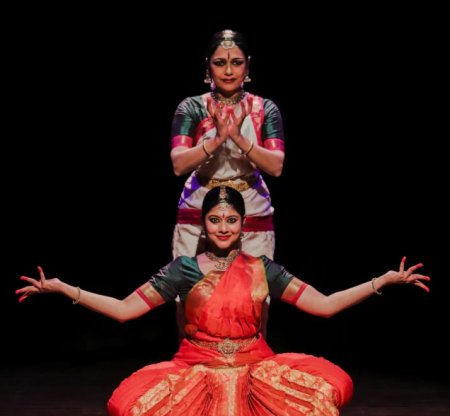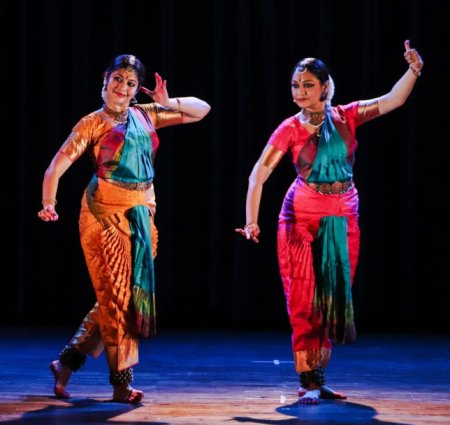
|   |

|   |
Taal Connect presents Dvita - Tapati Chowdhurie e-mail: tapatichow@yahoo.co.in Photos courtesy: Suman Sarawagi March 20, 2023 Suman Sarawgi and Sangita Dudhoria have together envisioned Taal Connect to bring to the people of Kolkata some of the choicest and best artistes of the country to enable aficionados taste the flavour of their art. From the time when the city was called Calcutta by the colonizers to the present times when it has reverted to its original name Kolkata, the city has been a paradise for art lovers; once you are able to ignite the interest in any art form, it becomes a fashion and a passion for them. So it has been for the genre of dance of the highly successful Rama Vaidyanathan, disciple of Yamini Krishnamurthy and later honed under Saroja Vaidyanathan. Almost every Bharatanatyam dancer in Kolkata worth their salt has a Rama Vaidyanathan choreographed piece in their kitty.  Rama Vaidyanathan and her daughter Dakshina Vaidyanathan Baghel mesmerized afficionados in Kolkata with the presentation of Dvita-a spiritual being who exists in two forms. The first piece was on Goddess Lakshmi, bestower of wealth and Goddess Saraswati, bestower of wisdom. It is well-known that wisdom is wealth if not taken too literally. Rama Vaidyanathan clad in white represented Saraswati while her daughter Dakshina clad in red was Lakshmi. They danced as one body merging into each other with great elan, before emerging as individual manifestations, which the wish and desire of bhaktas have lovingly bestowed upon them separate and innumerable qualities. The powerful 'beeja mantras' capable of making your desires a reality of the qualities of Lakshmi and Saraswati were chanted and danced in Rama's signature style of Bharatanatyam. The power and grit in the pure nritta portions inbetween the sahitya were applauded by her admirers. Songs in praise of Lakshmi and Saraswati blossomed like buds in the form of Alarippu, the first dance piece of the Bharatanatyam repertoire. The duo's rotation at one spot revealed their oneness. "Mohamaginen", a Dandayudapani Pillai composition in ragam Kharaharapriya and talam adi rendered solo by Dakshina Vaidyanathan was a deviation from the declared theme of the evening. Nonetheless this bhakti sringar raas piece held a sway over the audience. Bhakti sringara, the highest form of spiritual love, with the nayika professing power, energy and emotive quality of the dancer made us all sit back to enjoy as the love smitten mortal nayika surrendered all her feelings to her nayaka - Nataraja the lord of dance who resides in Chidambaram. The five arrows made of flowers - Aravinda, Ashoka, Choota, Navamallika and Neelotpala - thrust upon her by the God of love so intensified her longing for her lord that made her separation from him intolerable, was well expressed, a typical state of mind of a yearning lover.  The third piece to a composition of Annamacharya was interestingly about sambhog sringar, a frequently happening thing among medieval poets in the country. The chosen piece was in the form of a monologue, where poet Annamacharya tells Lord Venkateswara that his wife Alamelumanga was superior to him in the art of love making. It was a sort of happy defeat. In the piece Vaidyanathan described through her dance vocabulary how the expression of Alamelumanga's amorous eyes mesmerizes him. How her arms embracing him is more powerful than the love arrows of cupid and so on. The piece was absorbing. In Indian aesthetics all emotions are looked upon as natural and sacred and art merely imitates life. The penultimate piece by the mother-daughter duo was from the treasure trove of Sangam literature, in which the mother's realization of true love for her offspring would be to set her free to find her true love. A number of motifs brought home to the mother the nature of filial love. As the veena strings that house the seven notes have to be strung out by a skilled musician and as the example of the pearl that grows in the oyster finds appreciation when set in jewellery, it exemplified true love between a mother and daughter. The last piece Keertanam which is usually in praise of God was merged innovatively with Thillana which is a rhythmic piece, to give a different flavour. The success of the recital could perhaps be gauged by the standing ovation that lasted longer than usual.  Tapati Chowdhurie trained under Guru Gopinath in Madras and was briefly with International Centre for Kathakali in New Delhi. Presently, she is a freelance writer on the performing arts. |